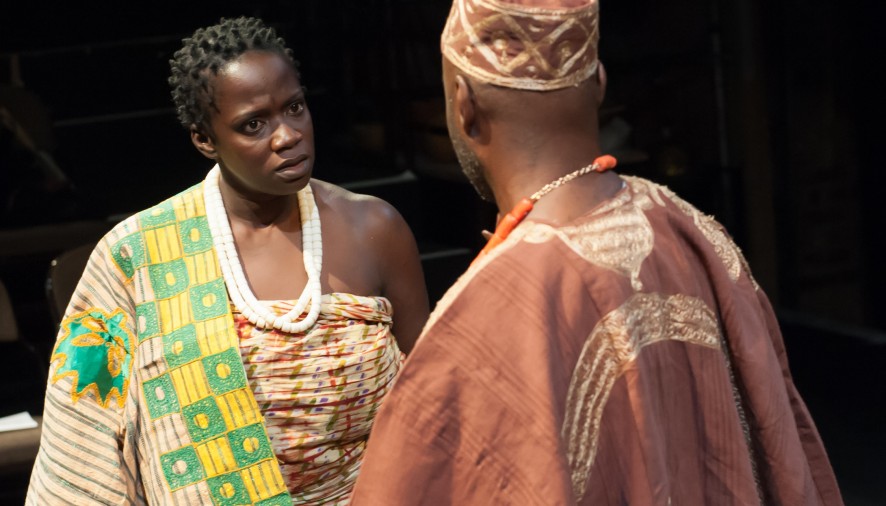After our recent interview with Director Moji Kareem, James Candler headed to the West Yorkshire Playhouse to give his thoughts on the finished production of Iyalode of Eti.
Iyalode of Eti is a Nigerian reimagining of the renaissance classic The Duchess of Malfi that attempts to demonstrate the universality of the play, and in doing so, allows new audiences to experience it. Director Moji Kareem is as successful as she is ambitious in her goal of reimagining such a well known story.
What Kareem brings to the production is a playful tone that oscillates between joyous and tragic. The play opens with a sombre funeral march, as the narrator tells of the tragic backstory of Iyalode. The scene is deliberately long, becoming almost uncomfortably dour, with the excellent Kehinde Bankole wearing an expression of agonising pain upon her face. The march of Iyalode is then abruptly halted by vibrant, celebratory dance, with all the cast engaging in the festivities. This stark dichotomy between joy and pain pervades the whole performance, but rather than appearing tonally unbalanced, and thereby rendering the play incoherent, it only enhances the experience. As a result, the play is able to explore the true nature of tragedy: if in fact people are capable of learning from mistakes, or if they simply carry on none the wiser.
The play is able to explore the true nature of tragedy: if in fact people are capable of learning from mistakes, or if they simply carry on none the wiser.
The entire cast deliver fine performances and, in keeping with the themes of the play, demonstrate a great capacity for both comedy and drama. Sole Akingbola plays the fiendish Akinba, the assassin hired to kill Iyalode, and portrays his character with a somewhat detached demeanour, meaning that his motivations remain sinister and mysterious right up until they are revealed. Patrice Naiambana’s delightfully over the top but still very heinous portrayal of Oloye Olorogun (the erratic brother of Iyalode) cannot go unmentioned; he provides much of the play’s comedy, but also proves himself capable of appearing genuinely threatening in one crucial scene.
Credit must also be given to the play’s imaginative staging. They transformed the small studio space with a small wooden circular platform, with totem poles carved with faces framing the stage. These greatly helped with the African setting of the play, and proved a great addition to the set, especially when the twisted faces of the carvings were lit up spectacularly with a ghoulish red light after the death of Iyalode.
The production made the wise choice to refrain from copious blood bags and messy deaths, instead using understated spots of red light to to represent deaths on stage. In a small space where the audience can see everything on stage it felt much more dignified, and the deaths appeared more tragic, whereas gore on stage would have detracted from the power of the piece. The costumes too were a particular highlight – vibrant and traditional, they brought a burst of colour to the stage amongst the gruesome events unfolding.
Iyalode of Eti is an absolute treat, which manages to bring something genuinely new to a play that has by now seemingly been studied and reimagined to death.
Iyalode of Eti is an absolute treat, which manages to bring something genuinely new to a play that has by now seemingly been studied and reimagined to death. The choice of setting the play in Nigeria was particularly innovative, as many parallels can be found between traditional Nigerian’s treatment of women and the Duchess’ manipulation within the play. But perhaps more importantly, the African setting helped open up a theatrical classic to black actors who perhaps unfairly wouldn’t have the opportunity to perform such a famous play otherwise, and gave prominence to Utopia Theatre, the black theatre company behind the play.
James Candler
(Image courtesy of Utopia Theatre)

